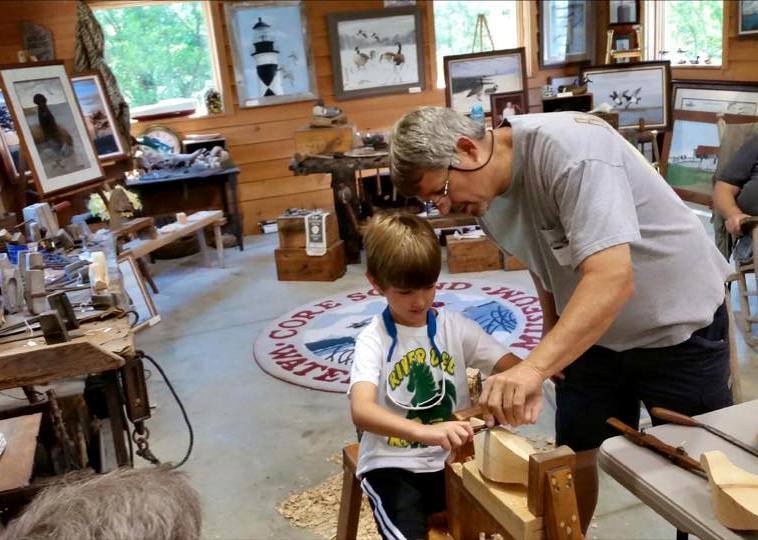HARKERS ISLAND — There are some places so special that they tempt travelers to remain quiet about their existence so as to keep them pristine.

Core Sound is one of those places. On Harker’s Island, at the end of the road, as they call it, is a place that will remind those folk hailing from islands and sleepy coastal towns of home: the Core Sound Waterfowl Museum and Heritage Center. It’s one of those special spots that visitors may be sorely tempted to keep all to themselves, as with the location of a sweet fishing honey hole. But oftentimes, it’s an experience so sweet it has to be shared like a honeycomb.
Supporter Spotlight
To introduce and draw visitors to their display of Down East coastal culture, the museum invites individuals and families to explore its new summer programs at no cost.
The featured programs include demonstrations of carving, quilting and shipbuilding; storytelling; and learning experiences with a children’s area that matches each experience to assist in reinforcing the theme for the week.
The museum preserves coastal North Carolina cultural artifacts and encourages visitors to come take part and touch history. Its concept was built on the foundation laid by the Core Sound Decoy Carvers Guild, a separate organizationfounded in the late 1980s and dedicated to the preservation of the waterfowl carving heritage of the Core Sound area. The Core Sound Waterfowl Museum and Heritage Center was founded in 1992.
According to Pam Morris, the manager of collections and operations,, the museum envisions coastal communities of eastern North Carolina in which culture, community, education, economy and the environment are fully integrated for a high quality of life for all residents.
Others on the staff agreed.”We want visitors to have an opportunity to see what this place is and then hopefully come back to see us again,” Teresa Everett, the science education coordinator, said.
With those visits, perhaps a seed of connection is planted along with the desire to preserve the natural beauty and culture for future generations.
Executive Director Karen Willis Amspacher explained that the museum’s vision is to share: to grow a seed of appreciation, in new and returning visitors, of a special place generations of seafarers and those sustaining themselves from and living connected to the sea call home “at the end of the road”
This summer’s free programming is designed to draw new visitors and showcase all the museum has to offer.
Volunteers from various walks of life and artistic and culturally inspired fields will share their expertise with visitors throughout the summer.
Summer programming includes three recurring events set to run June through August: Talkin’ Tuesday, Wanders and Wonders with Woz on Thursday and Soundside Storytime on Friday..
Talkin’ Tuesday showcases demonstrations and displays from local carvers, quilters, scientists and boatbuilders all day starting at 10:45 a.m. Talkin’ Tuesday’s started June 16.
Waterfowl carvers Walter “Brother” Gaskill and Monty Willis will be at the carving bench on alternating Tuesdays to spin yarns and demonstrate their well-honed technique of carving functional decoys.
Gaskill is a 2014 and 2015 winner in the Ward Museum of Waterfowl Art’s World Carving Championships held yearly in Ocean City, Md. Gaskill placed second in the world in the Shootin’ Rig category for the 44th and 45th annual world championships.

Watch Brother in action as he fashions lifelike waterfowl from various types of wood in a way that has become tradition through practice and experience. Listen to Gaskill describe his method for carving a bird that will ride upright in the water whether it’s “blowing a gale” or “slick calm.”
Beekeeper Randall Russell Lewis will share his knowledge of current honey making and his displays, which illustrate the development of apiary production from collection devices made from woven grasses to modern-day box hives.
Lewis claims the distinction as Harker’s Island first beekeeper. He was inspired by his memory of visits to see his great-grandfather’s bees in Sea Level. Those hives were fashioned from hollowed-out logs. Sticks laid across the top provided perches for the bees to build their honeycombs.
Lewis described how it required a little sweet-producing jaw work to get the golden treasure that served as their main source of candy in those days from the byproduct of the socializing bees.

“We’d chew on the combs down to the wax and spit them out,” Lewis explained.
Lewis shows visitors various aspects of beekeeping culture and explain nature’s delicate balance of which bees are a large part and in which humans also play a role.
On the first Talkin’ Tuesday, Lewis had to make multiple trips up a tree in 100-degree heat to reclaim a swarming hive that was trying to start anew somewhere else.
Beekeeping is but one of the traditions featured.
Quilter Phyllis Salak of Williston has community quilts on display and encourages visitors to take a hands-on approach to a lesson in quilting, another Down East tradition.
“If they want to put a few stitches in, we’ll let them,” Salak said.
Bonnie Hunter and Sharon Bailey will be working on their wall-hanging quilt that was inspired by luminaries. The plan is to display it during Waterfowl Weekend in December.

Also, in the newly expanded William E. Smith Children’s Area, guests can enjoy special stories geared toward preschoolers along with interactive games, a reading skiff, art supplies and music. Portions of the children’s area will also be tied in theme to the each week’s Talkin’ Tuesday topics in an effort to extend and reinforce the learning experience.
Thursdays will feature explorations and lessons with a favorite Down East teacher, John “Woz” Waszak. Woz’s focus is kids of elementary and middle school age, but all are welcome.
Wonders and Wanders with Woz includes a journey along Willow Pond Trail, beach seining using nets deployed from the shore.







